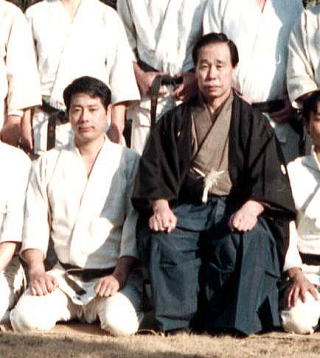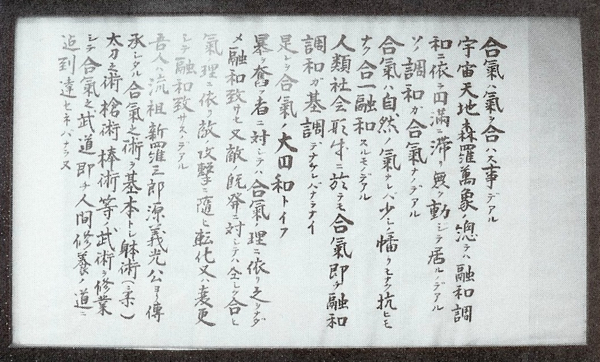
Keisetsu Yoshimaru with Yukiyoshi Sagawa
Keisetsu Yoshimaru and “Aikido no Ogi”
Keisetsu Yoshimaru trained in Daito-ryu under Yukiyoshi Sagawa from 1961 until 1976, after which time he separated from Sagawa Dojo. He continued to train in Chinese Bujutsu and other arts, such as a separate line of Daito-ryu descended from Kakuyoshi Yamamoto, who was, perhaps, the last student of Sokaku Takeda. He later established his own organization, the Aiki Rentaikai (合気練体会).
He published a number of interesting books in Japan, and remains a somewhat controversial figure in Daito-ryu. Some of the most interesting information in his books is his collection of quotes from Yukiyoshi Sagawa, many of which have never been translated into English before.
Yukiyoshi Sagawa started training with Sokaku Takeda around 1914, about a year before Morihei Ueshiba met Takeda at the Hisada Inn in Hokkaido. He was once considered to be the successor to Takeda Sokaku.
The quotes presented here are from the summary section of “Aikido no Ogi” (合氣道の奥義 / “The Secrets of Aikido”) – “Aiki no Rentai” (合気之錬体 / “The Conditioned Body of Aiki”). This section contains a summary of the quotes from Yukiyoshi Sagawa relevant to the conditioning of the body necessary for Aiki.
To set the stage before that, here are some short and casual comments on Aiki and Aiki-age (ie, “Kokyu Tanden-ho” in conventional Aikido) from another former student of Yukiyoshi Sagawa – it’s a little over ten years old, but still relevant, I think:
First, concerning Aiki-age.
In the Dojo there are people with many different ways of raising their hands. You could even say that each person is unique to themselves.
As for different ways of grabbing and so forth, that’s really not very relevant, because it’s really a matter of a problem with the person who is raising their hands.
I think that people are often told to relax their shoulders. This is an extremely important thing. As to how you actually relax your shoulders? That’s not taught even at Sagawa Dojo. Everybody must research that on their own. However, it may be one of the strengths of Sagawa Dojo that you learn to judge what is mistaken through your own research. Of course, you can’t get to that judgement right away.
The Aiki-age of Sagawa Dojo is like this. Absolutely no bending the wrists, close your armpits, focus your power on the point at which you are grabbed (Aiki is an internal sense, so this is difficult), relax your shoulders and raise your hands up without changing. That’s all.
Lastly, concerning Aiki. First of all, in Sagawa Dojo, “power” (力 / “chikara”, also meaning “strength”) and Aiki are completely seperated. And when speaking about “power”, it’s different from the kind of power that we normally use. “Martial” power (武術的な力 / “bujutsu-teki na chikara”)? Some people call it that, and some people call it the power of the extensor muscles. “T” shihan views the “extensor muscles” explanation negatively. I think that most of the students in the Dojo see it that way as well.
The first thing that new students learn is Martial power. They learn the effecient use of power in order to lay the groundwork for Aiki.
If you are intuitive then you may be able to grasp Aiki, although some people misunderstand, but if you don’t lay the groundwork well then intuition won’t help you at all.
One way to misunderstand Aiki is to mistake the power that your body gains through this groundwork for Aiki. The reason for this is that this power appears similar to Aiki when seen from the outside. Most of the black belts in the Dojo have this problem.
But the Aiki that is spoken of in Sagawa Dojo is a completely different thing. Sensei often said that if you don’t change your way of thinking you will not be able to glimpse Aiki. However, that Aiki is in fact an extension of this groundwork is not mistaken.
I guess that the only way to understand this is by going through the conditioning and changing your way of thinking. (more…)



